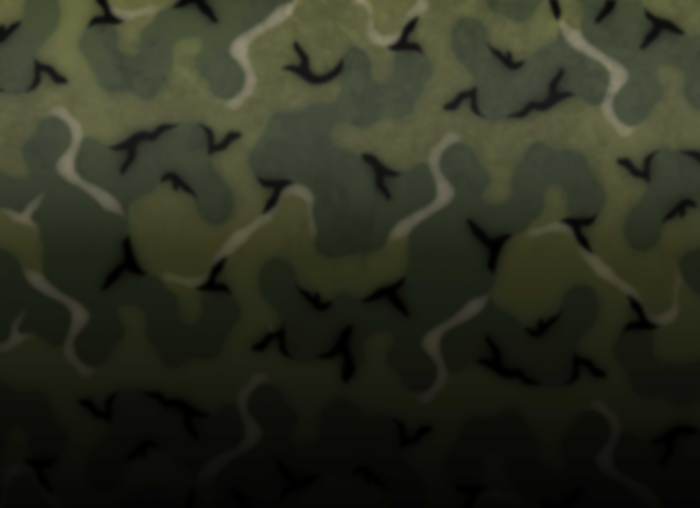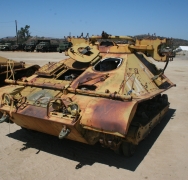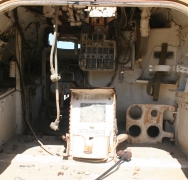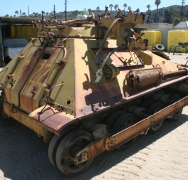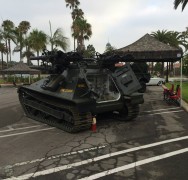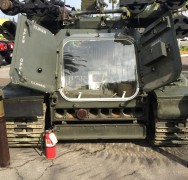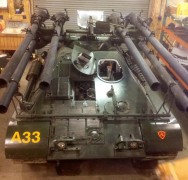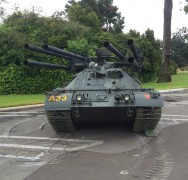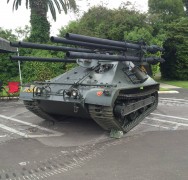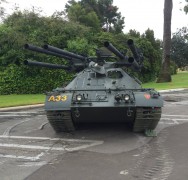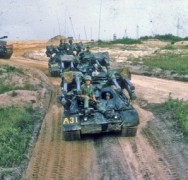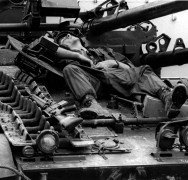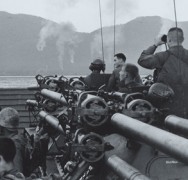M-50A1 Ontos
Development
The Ontos (Greek for “thing”) project was created to be an air transportable tank-destroyer capable of being lifted by the cargo aircraft of the 1950s. This limited it to a weight between 10 and 20 metric tons, the only other limitation to the design being that it had to use the six-cylinder engine then widely used in the army’s GMC trucks. Allis-Chalmers was awarded the contract on August 12, 1955, for 297 vehicles.
Allis-Chalmers’ first vehicle, completed in 1952, was based on the running gear of the M56 Scorpion light anti-tank vehicle. The vehicle mounted a cast steel turret with two arms holding three rifles each. This early model could traverse the turret only about 15 degrees. A second prototype used a new suspension system including new tracks, and a newer turret with about 40 degrees traverse. Only eighteen rounds for the main guns could be carried inside the vehicle due to limited space. Four of the rifles also had .50-caliber spotting rifles attached, firing a round with the same trajectory as the 106 mm round, that gave off a puff of smoke on impact. The spotting rifles were thus used to line up the 106 mm recoilless rifles with the target. A single .30 caliber M1919A4 machine gun was also carried for anti-infantry use.
The vehicle was taken to the Aberdeen testing facility where single rifles had been tested. When all six weapons were fired at once, the back blast from the firing knocked bricks out of a nearby building and knocked the rear windows out of several cars. The prototype and testing stage was completed by 1955, at which point the Army canceled its order. As an anti-tank vehicle the Ontos had several problems, including a small ammunition load, a very high profile for such a small vehicle, and the need for the crew to exit the vehicle in order to reload the guns, exposing them to enemy fire. Although the Army canceled their order, the Marine Corps were desperate for any anti-tank vehicles they could get, and ordered 297. Production ran from 1955 through 1957. The first vehicle accepted by the Marine Corps was on 31 October 1956.
Variants and upgrades.
Several variants were also studied. The Utility Vehicle, Tracked, Infantry, T55 was a light APC, but only two versions of the prototype were built. It proved impractical due to the limited room inside, carrying only five infantry and forcing the driver to lie prone. A “stretched” version known as the Utility Vehicle, Tracked, Infantry, T56 was also built, and while it held a complete eight-man team, their equipment had to be carried on the outside. Neither was considered very useful.
In 1960 there was a brief study made to replace the Ontos’s 106 mm rifles with a new 105 mm design that included a re-loading system similar to that on a revolver. This project was not accepted.
Another proposed upgrade was replacing the GMC engine with a newer Chrysler 361 in³ V8 engine. This upgrade was implemented and the variant was named Rifle, Multiple 106 mm, Self-propelled, M50A1. However of the 297 vehicles initially accepted by the Marines, only 176 were converted between 1963 to 1965 to this standard.
Service
While the M50 was designed as a tank destroyer, the NVA deployed few tanks. It was more widely used for direct fire support for the infantry in combat, a role that was never emphasized in training or doctrine. Like the army’s M113, its light armor was effective against small arms but vulnerable to mines and rocket-propelled grenades. Consequently many Ontos were deployed in static defense positions.
The Ontos was particularly liked by its crews, and praised by commanders. Their relatively light weight meant that the M50s could also go where tanks got bogged down. The Ontos, with its lower ground pressure, could drag timbers up to the tanks to help get them unstuck. In another operation, the Ontos was the only tracked vehicle light enough to cross a pontoon bridge. In the Battle of Hue, regimental commander Colonel Stanley Hughes felt the Ontos was the most effective of all marine supporting arms. Its mobility made it less vulnerable than tanks, which suffered heavy losses, while at ranges of 300 to 500 yards (270 to 460 m), its recoilless rifles could knock holes in or completely knock down walls. The appearance of an Ontos was sometimes enough to make the enemy break and run, and anecdotal accounts describe the enemy fleeing occupied buildings when an Ontos’s spotting round entered a window. In Operation DeSoto, the introduction of the large CH-53 Sea Stallion helicopter made possible moving a platoon 25 miles (40 km) south of Quan Ngai City carrying Ontos in slings underneath the aircraft.
The Ontos units were deactivated in May 1969, and some of the vehicles were handed over to an army light infantry brigade. They used them until they ran out of spare parts, and then removed the turrets and used them as fixed fortifications. Both these and the rest of the vehicles returned from Vietnam in 1970 and were cut up for scrap, with some of the chassis being sold off as construction vehicles.
